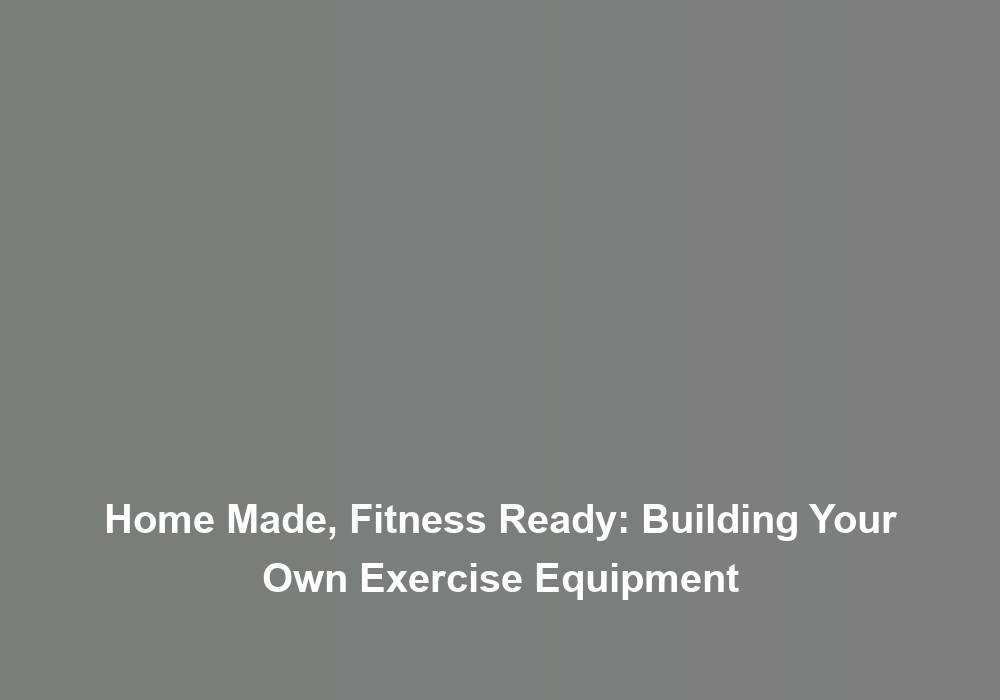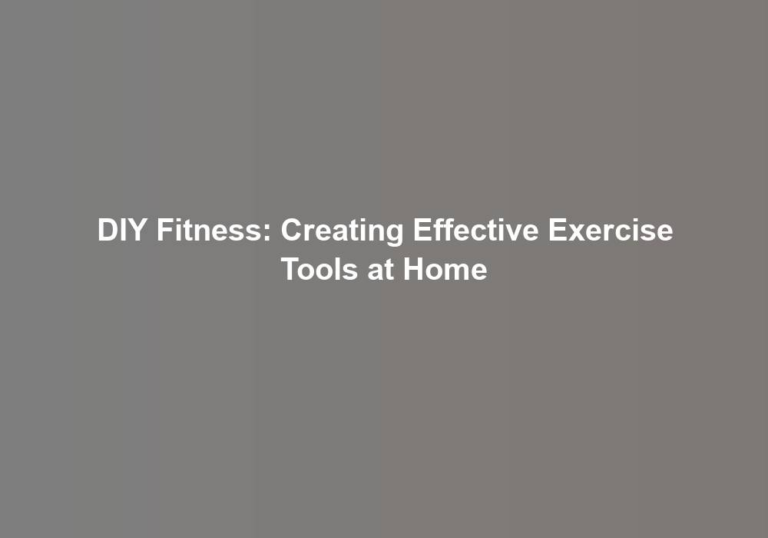Home Made, Fitness Ready: Building Your Own Exercise Equipment
YouG??ve probably heard the saying, G??If you want something done right, do it yourself.G?? Well, when it comes to your fitness routine, this sentiment can hold true. Imagine having exercise equipment tailored to your specific needs, all while saving money and enjoying the satisfaction of crafting it with your own hands. Whether youG??re looking to build strength, improve flexibility, or enhance your cardio workouts, the possibilities are endless when you take matters into your own hands. And the best part? You donG??t need to be a professional carpenter or engineer to make it happen. Curious to discover how you can elevate your home workout experience with DIY exercise equipment?
Essential Tools and Materials
YouG??ll need basic tools like a saw, drill, and screwdriver, as well as materials such as wood, metal pipes, and resistance bands to start building your own exercise equipment. When it comes to woodworking basics, having a saw is essential. A circular saw or a hand saw will be useful for cutting wood to the required dimensions. A drill is also indispensable for creating holes and assembling components securely. Additionally, a screwdriver set with various head types will aid in fastening parts together. For metal fabrication, a hacksaw or a metal cutting bandsaw will be necessary for cutting and shaping metal pipes. A metal drill bit is crucial for creating holes in metal components. Along with these tools, using clamps to hold materials together during assembly will make the process easier and safer.
For woodworking basics, itG??s important to select the right type of wood for your equipment. Plywood is a popular choice due to its strength and affordability. You can also consider using solid wood for certain parts to enhance durability. When it comes to metal fabrication, galvanized steel pipes are a sturdy option for constructing frames, while metal brackets and fasteners will help to secure the structure. Lastly, incorporating resistance bands into your equipment will add versatility to your workouts, so be sure to have these on hand as well.
Building a Sturdy Weightlifting Bench
To construct a sturdy weightlifting bench, you can start by selecting high-quality, durable materials that can withstand heavy use and provide reliable support during workouts. Consider the following steps to ensure a sturdy design and adjustable incline:
-
Choose the Right Wood: Opt for strong, dense woods like oak or maple to ensure the bench can support a substantial weight capacity without warping or breaking.
-
Utilize Solid Joinery Techniques: Employ woodworking techniques such as mortise and tenon joints or dovetail joints for maximum strength and stability, ensuring the bench can withstand the rigors of weightlifting.
-
Reinforce Critical Stress Points: Identify critical stress points on the bench and reinforce them with additional bracing or supports to enhance the overall sturdiness and durability of the design.
-
Ensure Adjustable Incline Mechanism: If you desire an adjustable incline feature, use high-quality hardware and mechanisms that allow for smooth and secure adjustments, providing versatility for various exercises.
Constructing Customizable Resistance Bands
If youG??re looking to create customizable resistance bands, consider using high-quality elastic material that can be easily adjusted to provide varying levels of resistance for your workouts. Customizable tension levels are essential for targeting different muscle groups and accommodating various fitness levels. To construct these bands, start by selecting a durable elastic material that can withstand stretching and intense usage. Opt for a material with varying thickness options to adjust the resistance levels. Additionally, incorporating handles or loops at each end of the band can enhance its versatility, allowing for a wider range of exercises. Remember to securely attach these handles or loops to ensure safety during your workouts.
When constructing customizable resistance bands, itG??s crucial to focus on creating portable workout options. This means designing the bands to be easily transportable, enabling you to incorporate resistance training into your fitness routine wherever you go. Consider adding a storage bag or pouch to keep your bands organized and readily available for use at home, in the gym, or while traveling.
Crafting a Versatile Plyometric Box
Crafting a versatile plyometric box allows you to expand your home workout equipment, providing a dynamic option to enhance your resistance band exercises and add variety to your fitness routine. Building your own plyometric box is a cost-effective way to introduce plyometric training into your workouts. HereG??s how to craft a versatile plyometric box that suits your needs:
-
Custom Measurements: When crafting your plyometric box, consider your own fitness level and the exercises you plan to perform. Customizing the box to different heights will allow you to progress gradually, ensuring a safe and effective workout.
-
Safety Precautions: As you construct your plyometric box, prioritize safety by securely fastening all edges and ensuring the box can support your weight. Sanding down any rough edges will also help prevent injuries during use.
-
Multipurpose Functionality: By building a plyometric box with multiple levels or sides, you can diversify your workouts and target different muscle groups. This versatility adds excitement and challenge to your fitness routine.
-
Community Connection: Building a plyometric box can also connect you with a community of like-minded fitness enthusiasts. Sharing your experiences and learning from others who have crafted their own equipment can foster a sense of belonging and motivation.
Crafting a versatile plyometric box tailored to your needs not only enhances your home workout space but also provides a sense of accomplishment and empowerment as you take charge of your fitness journey.
DIY Solutions for Cardio and Flexibility
Looking to improve your cardio and flexibility at home without expensive equipment? Here are some practical and cost-effective DIY solutions to help you achieve your fitness goals.
For yoga mat alternatives, consider using a folded towel or blanket as a space-saving option. These items provide sufficient cushioning and support for various yoga poses and stretching exercises. Additionally, you can repurpose an old, non-slip rug or use a large, soft area rug to create a makeshift yoga mat. These alternatives are not only budget-friendly but also versatile and easy to store.
When it comes to cardio, a DIY jump rope offers a simple and effective workout tool. You can easily create a jump rope using inexpensive materials such as PVC pipe or clothesline rope. By adjusting the length to suit your height, you can personalize the jump rope for an optimal workout experience. Jumping rope is a great way to elevate your heart rate, improve coordination, and burn calories without the need for bulky or costly equipment.
Conclusion
Now that youG??ve built your own exercise equipment, youG??re ready to take your fitness to the next level. Did you know that 80% of people who exercise at home are more likely to stick to their workout routine? By creating your own equipment, youG??re taking a big step towards achieving your fitness goals and staying motivated. Keep pushing yourself and enjoy the benefits of a healthier, stronger you!







